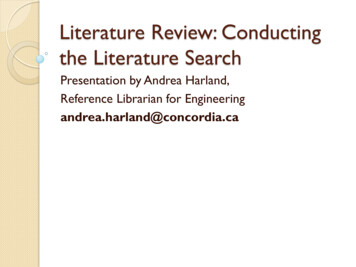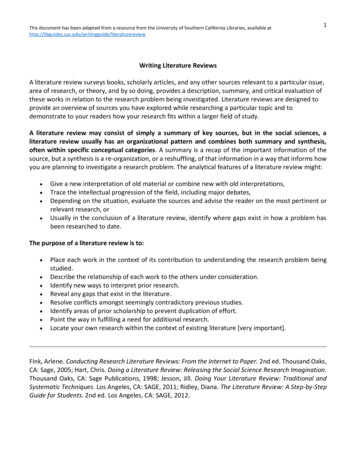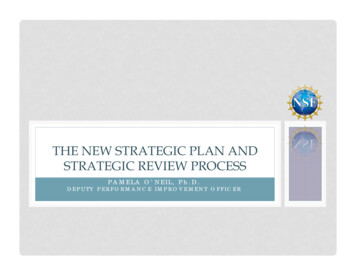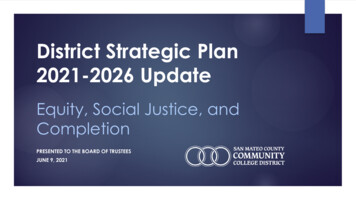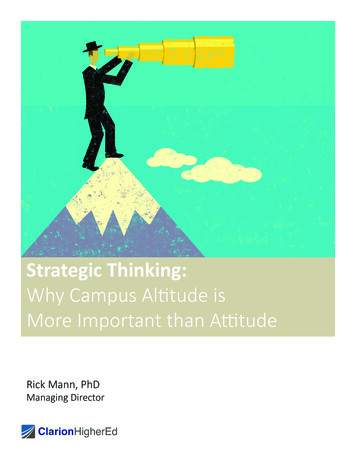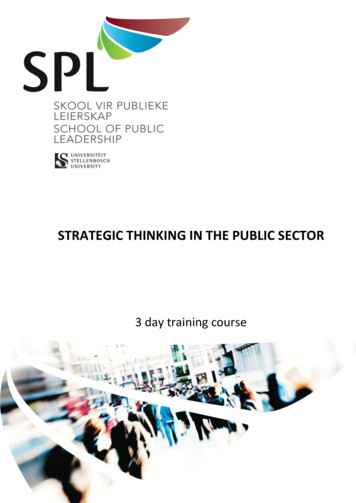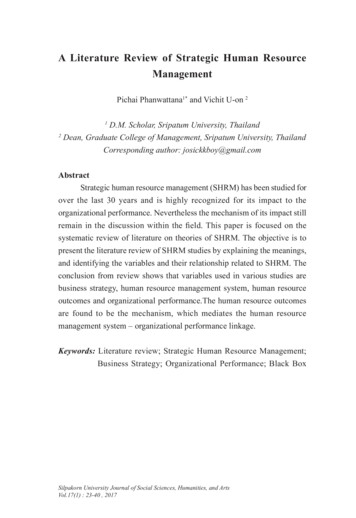
Transcription
A Literature Review of Strategic Human ResourceManagementPichai Phanwattana1* and Vichit U-on 2D.M. Scholar, Sripatum University, Thailand2Dean, Graduate College of Management, Sripatum University, ThailandCorresponding author: josickkboy@gmail.com1AbstractStrategic human resource management (SHRM) has been studied forover the last 30 years and is highly recognized for its impact to theorganizational performance. Nevertheless the mechanism of its impact stillremain in the discussion within the field. This paper is focused on thesystematic review of literature on theories of SHRM. The objective is topresent the literature review of SHRM studies by explaining the meanings,and identifying the variables and their relationship related to SHRM. Theconclusion from review shows that variables used in various studies arebusiness strategy, human resource management system, human resourceoutcomes and organizational performance.The human resource outcomesare found to be the mechanism, which mediates the human resourcemanagement system – organizational performance linkage.Keywords: Literature review; Strategic Human Resource Management;Business Strategy; Organizational Performance; Black BoxSilpakorn University Journal of Social Sciences, Humanities, and ArtsVol.17(1) : 23-40 , 2017
A Literature Review of Strategic Human ResourcePichai Phanwattana and Vichit U-onIntroductionIn a competitive environment today, organization need tocontinuously improve its performance whether by reducing cost, orenhancing product and service quality in order to effectively competein the market. Strengthening human resource management is consideredas one of the solutions to elevate organizational performance throughorganization capability (Katou, 2010; Chang and Huang 2005). In recentstudies, business strategy is the core factor that leads to human resourcemanagement systems (Andersen et al., 2007; Muduli, 2012; Katou andBudhwar, 2010; Schuler and Jackson, 1989; Collings et al., 2010; Chowet al., 2008; Bao et al., 2011). In addition, numbers of studies indicatedthat HRM has a direct impact on human resource outcomes (Snell andDean, 1992; Youndt and Snell, 2004, Takeuchi et al., 2007; Guthrie et al.,2011; Katouand Budhwar, 2010; Katou, 2012; Arthur, 1994; Huang, 2001;Guthrie et al., 2009) and organizational performance (MacDuffie, 1995;Guthrie et al., 2009; Huselid, 1995; Delery and Doty, 1996; Nigam et al.,2011; Absar et al., 2012; Khan, 2010; Su and Wright, 2012)The objective of this article is to present the literature review ofstrategic human resource management (SHRM) studies to explainmeanings, variables, and their relationship related to SHRM.HR OutcomesBusinessstrategyHRM systemOrganizationalprerformancenFigure 1: Conceptual model24
Silpakorn UniversityJournal of Social Sciences, Humanities, and ArtsStrategic Human Resource Management (SHRM)The term “Strategic human resource management (SHRM)” wasintroduced, according to Devanna, Fombrun, and Tichy (1981). Humanresource management: A strategic perspective which shifts the focus onperform role such as training and benefit to integration and organization,driven by human resource management value added.The evolution of SHRM from human resource management isfocused on the issue of human resource management in organizationperspective context, instead of individual perspective context and its roleto support the business (Liao, 2005). The main study context was provenagainst the relationship and alignment of business strategy and HRMto the organizational performance (Bao et al., 2011; Shameem, 2011;Luna-arocas and Camp, 2008).The term strategic human resource management was well-definedby Wright and McMahan (1992) as “the pattern of planned human resourcedeployments and activities intended to enable an organizationto achieveits goals” (p. 298)From the literature review, the principle of study has shifted fromtesting various human resource practices individually toward testingthe whole human resource management systems as a bundle, becausethose practices operates with a synergistic effect. In addition, organizationalworkforce does not interact with single practice but all of practicesas a systems (Ichniowski et al., 1997; Becker and Huselid, 1998;Lepak et al., 2006).Therefore, the author defined strategic human resource managementfrom literature review as the effective use of human resource fororganization’s strategic needs via the integration of planned humanresource practices aligned with business strategy to achieve organizationalperformance and competitive advantages (Wright and McMahan,1992; Chang and Huang, 2005; Chan and Mak, 2012; Altarawnehand Aldehayyat, 2011)25
A Literature Review of Strategic Human ResourcePichai Phanwattana and Vichit U-onKaufman and Miller (2011) observed that organizations’ choice ofhuman resource management practices normally followed thethree typology developed by Delery and Doty (1996), which areuniversalistic, contingency, and configurational perspectives.The universalistic was considered to be the best practice. Meanwhile,the contingency and configurational perspectives were consideredto be best fit. However, universalistic perspective could be argued onwhether or not there is actually a certain best practices that any organizationscould benefit by adopting single approach. Contingency perspectivecould be argued that the best choice to select practices depends on eachorganization’s context. Configurational perspective could be arguedthat some configurations are better than others, and can yieldmore performance.Earlier studies of SHRM employed different human resourcesystems such as, control human resource management (Arthur, 1994),high-commitment HR systems (Arthur,1994; MacDuffie, 1995;Pfeffer, 1998; McClean and Collins, 2011), high-performance worksystems (Huselid, 1995; Selden et al., 2013), and Innovative HRMsystems (Ichniowski et al., 1997). However, from different HRMsystems reported above, they all shared the same objective which is tomaximize profit through people (Pfeffer, 1998; Lepak et al., 2006;Su and Wright, 2012). Boxall and Mackey (2007) explained a commonrelationship of different HRM systems including: to empoweremployees, to develop skills, and to motivate employees.The author defined human resource management systems as thebundles of human resource practices separated from each other, butare synergistically operated and related. It is consisted of recruitmentand selection, training and development, internal mobility, compensation,employment security, performance management, work design, andinvolvement (Delery and Doty, 1996; Sun et al., 2007; Becker andHuselid, 1998; Wright et al., 2003; Lee et al., 2010; Katou, 2012; Khanet al., 2013; Ichniowski et al., 1997; McClean and Collins, 2011; Guthrieet al., 2011; MacDuffie, 1995; Huselid, 1995).26
Silpakorn UniversityJournal of Social Sciences, Humanities, and ArtsBusiness StrategyPorter’s (1985) competitive strategies concept is the main strategyused in SHRM studies (Buller and McEvoy, 2012; Schuler and Jackson,1989; Huang, 2001). Scholars agreed that the heart of SHRM study isorganizations’ competitive advantages, which are derived fromalignment of HRM systems and business strategy (Schuler andJackson, 1989; Huselid et al., 1997; Huang, 2001; Chow et al., 2008;Azmi, 2011; Katou, 2012)Porter (1985) conceptualized business strategy in three patternsincluding 1) cost leader strategy 2) differentiate strategy and 3) focusstrategy.Schuler and Jackson (1987) has developed strategy to use in HRMstudy based on porter’s three pattern which is 1) innovation strategy2) quality enhancement strategy and 3) cost reduction strategy that arewidely used in SHRM study (Huang, 2001; Liao , 2005; Chow et al., 2008;Bao and Analoui, 2011; Lee et al., 2010)Business strategy can be defined from literature review as thechoice of pattern that organization choose to position themselves inthe market in order to gain competitive advantage, which consist ofinnovation strategy, quality enhancement strategy, and cost reductionstrategy (Porter, 1985; Schuler and Jackson, 1987; Arthur, 1992;Huang, 2001; Liao , 2005; Chow et al., 2008; Bao and Analoui, 2011;Lee et al., 2010)Human Resource OutcomesBecker and Huselid (2006) stated that the theoretical and empiricalchallenge in SHRM literature and study was the linkage between HRMand organizational performance, which many scholars used the term“Black box” to make a clearer picture. Dyer and Reeves (1995) hascategorized outcome and suggested that human resource outcomes arethe main product of HRM systems which directly impact organizationalperformance. Hence, in order to understand linkage between HRMand organizational performance, the relationship between HRM and HRoutcomes must be studied (Wright et al., 2003). However, there is a limited27
A Literature Review of Strategic Human ResourcePichai Phanwattana and Vichit U-onnumber of study that explored this linkage (Elorza et al., 2011)Human capital is one of the main interest topic in study of strategicHRM. Wright and McMahan (2011) stated that the issue of humancapital is how the organization decide to invest in employee such as,training and development, provide education in form of scholarship.In the empirical studies that employ human capital theory, scholarshad shown the effect of human capital on organizational performancethrough the accumulate of human capital in organization (Youndt andSnell, 2004; Teo et al., 2011).The studies of high-performance work systems – HPWS,employees’ attitude and behaviour has been emphasized as a mediatevariable (Boxall and Macky, 2007). Many studies conceptualizedby blending Resource-based view – RBV theory, Ability, Motivationand Opportunity – AMO theory, Human capital theory and Behaviouralperspectives to support the hypothesis (Kaufman and Miller, 2011;Way and Johnson, 2005).Numbers of empirical studies has confirmed that HRM outcomesis the “black box” variable mediated between HRM and organizationalperformance in SHRM literature (Way and Johnson, 2005).Therefore, the author defined HR outcomes as the direct outcomeoccurred from human resource management consist of human capital,employees’ attitude and employees’ behaviour (Youndt and Snell, 2004;Takeuchi et al., 2007; Guthrie et al., 2011; Katou and Budhwar, 2010;Katou, 2012, 2010, 2008; Park et al., 2003)Organizational PerformanceDess and Robinson Jr. (1984) indicated that organizationalperformance is the crucial factor of empirical study in the field of businesspolicy. In the past, financial performance such as return on investment –ROI, and economic value analysis – EVA are widely used as performanceindicators for executive in planning and controlling.Dyer and Reeves (1995) proposed four types of organizationalperformance measurement as the following: (1) Human resource outcome28
Silpakorn UniversityJournal of Social Sciences, Humanities, and Artseffect from human resource management practices which concerningattitude (job satisfaction and organization commitment) and behavior(turnover and absenteeism) 2) Operational performance which concerningproductivity and shrinkage 3) Financial performance which concerningprofitability and 4) Market performance which reflected from share priceof organization.Zupan and Koše (2005) noted that most of SHRM studies measuredorganizational performance that are profit-related or market-value-related,then proposed indicators for more balance to use as a measurement oforganizational performance, which included both objective and subjectiveperformance. Objective performance indicators included, for example,return on asset – ROA, EBIT per employee, return on investment – ROI,Tobin’s q, and market value. On the other hand, subjective performanceincluded customer satisfaction, product or service quality, new product orservice, and relative competitive position and organization reputation.Becker et al. (1997) also stated that market-related performance indicatorsare more appropriate for HRM study because they reflected the presentvalue of organization cash flows.The author defined organizational performance from literaturereview as three dimensions of organization’s performance consist ofmarket performance, operational performance, and financial performance(Huselid, 1995; MacDuffie, 1995; Delery and Doty, 1996; Huang, 2001;Wright et al., 2003; Youndt and Snell, 2004; Chow et al., 2008; Baoet al., 2011).Relationship between Business Strategy and Human ResourceManagementThe relationship of Jackson and Schuler (1987) strategy and humanresource management could be explained that organizations which adoptcost reduction strategy required employees to work harder. On the otherhand, organizations which adopt quality enhancement strategy requiredemployees to work smarter. And lastly, organizations which adoptinnovation strategy required employee to do the job differently from29
A Literature Review of Strategic Human ResourcePichai Phanwattana and Vichit U-oncurrent state (Muduli, 2012).The author has reviewed empirical study that report business strategyand HRM linkage. There are significant effects such as study ofAndersen et al. (2007) found that in Australia, HRM that align withbusiness strategy has positive effects on organizational performance.This idea was in line with Muduli (2012) who reported that businessstrategy is the crucial factor to plan strategic human resource management.In Greece context, Katou and Budhwar (2010) found that the humanresource management designed from business strategy has a significanteffect on organizational performance. Moreover, Business strategyalso affected on human resource management capability and motivation.Collings et al. (2010) reported the relationship of the alignment ofHRM and business strategy directly impact employees’ skills, motivation,and organizations’ financial performance in Turkey.Relationship between Human Resource Management Systems,Human Resource Outcomes, and Organizational PerformancePrevious empirical studies on different human resource managementsystems and organizational performance linkage have been well-studied(Su and Wright, 2012).Many studies depicted direct relationship betweenhuman resource management and organizational performance. For instance,study of Huselid (1995) found that organization in diverse industries haveimproved organizational performance by employing high-performancework system. Organizations also yielded higher productivity and financialperformance improvement with lower turnover rate. Moreover, it alsoshown that one point in standard deviation of using high-performancework system has impact of 7.05 percent on turnover, sales growth 27,044,market growth 18,641, and 3,814 more profit than organizations didn’temploy the system. Ichniowski et al. (1997) claimed that the Innovativehuman resource system was highly impacted the overall performance ofemployees.In addition, numbers of studies had shown that human resourcemanagement systems has positive impact on employees’ attitude and30
Silpakorn UniversityJournal of Social Sciences, Humanities, and Artsbehaviour. This led to greater efficiency in productivity, as well as tothe overall performance (Fey et al., 2009; Messersmith et al., 2011;Kazlauskaite et al., 2012). Scholars argued that human resourceoutcomes (such as human capital, employee commitment, absenteeism,and turnover) are crucial factor between human resource managementsystems and organizational performance linkage (Klaas et al., 2012;Khan et al., 2013; Guthrie et al., 2009; Kim, 2012).In support the argument, Park et al. (2003) study of JapaneseMNCs firms reported that skills, attitude, and motivation were the elementsof HR outcomes derived from HRM system. Messersmith et al. (2011)proved this point of impact on employees’ attitude and behavior towardbetter organizational performance with solid evidence from the case onNPO organizations in Wales. Muduli (2012) study of Indian reportedthat HR outcomes consisted of commitment, satisfaction and motivationtogether contributed to better organizational performance.In study of Elorza et al. (2011) which exploring the “black box” inSpanish context also found the mediate effect of higher commitment effecton lower absenteeism then contribute to productivity. These diversecontext study has confirmed the mediator effect of HR outcomes,which is the “black box” between HRM systems and organizationalperformance linkage.Numbers of scholars supported SHRM studies consistentlymentioned that human resource management systems impactedboth organizational monetary and non-monetary performance.To conclude from literature review, it can be argued that humanresource management systems, so called “bundle” of humanresource practices aligned with business strategy directly impactedon human resource outcomes which are human capital (Snell andDean, 1992; Youndt and Snell, 2004, Takeuchi et al., 2007; Guthrieet al., 2011) and employees’ attitude and behavior (Katou andBudhwar, 2010; Katou, 2012; Arthur, 1994; Huang, 2001; Guthrieet al., 2009) and organizational performance, which areproductivity improvement (MacDuffie, 1995; Guthrie et al., 2009)31
A Literature Review of Strategic Human ResourcePichai Phanwattana and Vichit U-onfinancial performance improvement (Huselid, 1995) organizationeffectiveness (Delery and Doty, 1996). Fey et al. (2009) and Guthrieet al. (2009) reviewed and reported that the results are proved in manycontexts such as USA (Arthur, 1994; Huselid, 1995; MacDuffie, 1995;Delery and Doty, 1996; Huselid et al., 1997; McClean and Collins, 2011),United Kingdom (Guest et al., 2003, Guthrie et al., 2009), China (Su andWright, 2012; Chow et al. , 2008), Taiwan (Huang, 2001; Chang andHuang, 2005), and Greece (Katou, 2012).MethodologyThis article’s purpose is to review the SHRM studies in order to definethe characteristics, identify factors, concept, approach used in literature,in the purpose to use in author empirical research. The articles used in thisreview are selected articles that related to strategic human resourcemanagement literature mainly from EBSCO, Emerald and Elsevier database.To continue with review on SHRM and an endeavor to bring someclarity on the area of SHRM study, this paper focuses on the systematicreview of literature on theories of SHRM. Determining defining attributes,identifying the antecedents and consequences of the concept, explainsrelationship between variables and defining the empirical references for theconcept. Emphasis is refer to the future on specifically on variables used inSHRM study, which are business strategy, HRM system, HR outcomes,and organizational performance. Both quantitative and qualitative methodscan be applied to conduct an analysis in Thailand context in order to expandthe field of study.Results and discussionThe results of the concept analysis include the uses of theconceptualization and definition of SHRM attributes, antecedent, theconsequences, the relationships, and the empirical references.ConclusionThe finding from this study can summarize that SHRM is one crucial32
Silpakorn UniversityJournal of Social Sciences, Humanities, and Artspart that contributed to organization performance. The numbers of researchhas shown that variables used in SHRM study are business strategy,human resource management systems, human resource outcomes, andorganizational performance.The black box that mediate the relationshipbetween HRM system and organizational performance, which is HRoutcomes also reveal according to the literature reviewed in this study.AcknowledgementThis article would not have been possible without the help andassistance of a few individuals who have provided me with invaluablesupport during its writing. The author gratefully acknowledges Asst. Prof.Dr. Vichit U-on, my advisor for the guidance and enthusiasm.33
A Literature Review of Strategic Human ResourcePichai Phanwattana and Vichit U-onReferenceAbsar, N., Nimalathasan, B., and Mahmood, M. (2012) HRM-MarketPerformance Relationship: Evidence from Bangladeshi Organizations.South Asian Journal of Global Business Research 1(2): 238-255.Altarawneh, I. I. and Aldehayyat, J. S. (2011) Strategic Human ResourcesManagement (SHRM) in Jordanian Hotels. International Journal ofBusiness and Management 6(10): 242-255.Andersen, K. K., Cooper, B. K., and Zhu, C. J. (2007) The Effect ofSHRM Practices on Perceived Firm Financial Performance: SomeInitial Evidence from Australia. Asia Pacific Journal of HumanResources 45(2): 168-179.Arthur, J. B. (1992) The Link Between Business Strategy and IndustrialRelations Systems in American Steel Minimills. Industrial and LaborRelations Review 45(3):488-506.Arthur, J. B. (1994) Effects of Human Resource Systems on ManufacturingPerformance and Turnover. The Academy of Management Journal37(3):670-687.Azmi, F. T. (2011) Strategic Human Resource Management and Its Linkagewith HRM Effectiveness and Organizational Performance: Evidencefrom India. The International Journal of Human Resource Management22(18): 3888-3912.Bao, C., Gordon, R. and Analoui, F. (2011) An Exploration of The Impactof Strategic International Human Resource Management on FirmPerformance: The Case of Foreign MNCs in China. InternationalJournal of Management and Information Systems 15(4): 31-40.Batt, R. and Banerjee, M. (2012) The Scope and Trajectory of Strategic HRResearch: Evidence from American and British Journals. TheInternational Journal of Human Resource Management 23(9):1739-1762.Becker, B. E. and Huselid, M. A. (1998) High Performance Work Systemsand Firm Performance: A Synthesis of Research and ManagerialImplications. Research in Personnel and Human ResourcesManagement 16: 53-101.34
Silpakorn UniversityJournal of Social Sciences, Humanities, and ArtsBecker, B. E. and Huselid, M. A. (2006) Strategic Human ResourcesManagement: Where Do We Go From Here?. Journal ofManagement 32(6): 898-925.Boxall, P. and Macky, K. (2007) High-Performance Work Systemsand Organisational Performance: Bridging Theory and Practice. AsiaPacific Journal of Human Resources 45(3): 261-270.Buller, P. F. and McEvoy, G. M. (2012) Strategy, Human ResourceManagement and Performance: Sharpening Line of Sight. HumanResource Management Review 22: 43-56.Chan, S. C. H. and Mak, W. (2012) High Performance Human ResourcePractices and Organizational Performance The Mediating Role ofOccupational Safety and Health. Journal of Chinese Human ResourceManagement 3(2):136-150.Chang, W. A. and Huang, T. C. (2005) Relationship between StrategicHuman Resource Management and Firm Performance a contingencyPerspective. International Journal of Manpower 26(5): 434-449.Chow, I. H., Huang, J., and Liu, S. (2008) Strategic HRM in China:Configurations and Competitive Advantage. Human ResourceManagement 47(4):687-706.Collings, D. G., Demirbag, M., Mellahi, K., andTatoglu, E. (2010) StrategicOrientation, Human Resource Management Practices andOrganizational Outcomes: Evidence from Turkey. The InternationalJournal of Human Resource Management 21(14): 2589-2613.Delery, J. E. and Doty, D. H. (1996) Modes of Theorizing in Strategic HumanResource Management: Tests of Universalistic, Contingency, andConfigurational Performance Predictions. Academy of ManagementJournal 39(4): 802-835.Dess, G. G. and Robinson Jr., R. B. (1984) Measuring OrganizationalPerformance in the Absence of Objective Measures: The Case of thePrivately-held Firm and Conglomerate Business Unit. StrategicManagement Journal 5: 265-273.35
A Literature Review of Strategic Human ResourcePichai Phanwattana and Vichit U-onDevanna, M. A., Fombrun, C., andTichy, N. (1981) Human ResourceManagement: A Strategic Perspective. Organizational Dynamics :51-67.Dyer, L. and Reeves, T. (1995) Human Resource Strategies and FirmPerformance: What Do We Know and Where Do We Need to Go?.The International Journal of Human Resource Management 6(3):656-670.Elorza, U., Aritzeta, A., and Ayestarán, S. (2011) Exploring the Black Boxin Spanish Firms: The Effect of the Actual and Perceived System onEmployees’ Commitment and Organizational Performance. TheInternational Journal of Human Resource Management 22(7):1401-1422.Fey, C. F., Morgulis-Yakushev, S., Park, H. J., and Björkman, I. (2009)Opening the Black Box of the Relationship between HRM Practicesand Firm Performance: A comparison of MNE subsidiaries in theUSA, Finland, and Russia. Journal of International Business Studies40: 690-712.Guthrie, J. P., Flood, P. C., Liu, W., and MacCurtain, S. (2009) HighPerformance Work Systems in Ireland: Human Resource andOrganizational Outcomes. The International Journal of HumanResource Management 20(1): 112-125.Guthrie, J. P., Flood, P. C., Liu, W., MacCurtain, S., and Armstrong, C.(2011) Big Hat, No Cattle? The Relationship Between Use ofHigh-Performance Work Systems and Managerial Perceptions of HRDepartments. The International Journal of Human ResourceManagement 22(8): 1672-1685.Huang, T. C. (2001) The Effects of Linkage between Business and HumanResource Management Strategies. Personnel Review 30(2): 132-151.Huselid, M. A. (1995) The Impact of Human Resource ManagementPractices on Turnover, Productivity, and Corporate FinancialPerformance. Academy of Management Journal 38(3): 635-672.36
Silpakorn UniversityJournal of Social Sciences, Humanities, and ArtsHuselid, M. A., Jackson, S. E., and Schuler, R. S. (1997) Technical andStrategic Human Resource Management Effectiveness as Determinantsof Firm Performance. Academy of Management Journal 40(1):171-188.Ichniowski, C., Shaw, K., and Prennushi, G. (1997) The Effects of HumanResource Management Practices on Productivity: A Study of SteelFinishing Lines. The American Economic Review 87(3): 291-313.Katou, A. A. and Budhwar, P. S. (2010) Causal relationship between HRMpolicies and organisational performance: Evidence from the Greekmanufacturing sector. European Management Journal 28: 25-39.Katou, A. A. (2012) Investigating Reverse Causality between HumanResource Management Policies and Organizational Performance inSmall Firms. Management Research Review 35(2): 134-156.Kaufman, B. E. and Miller, B. I. (2011) The Firm’s Choice of HRMPractices: Economics Meets Strategic Human Resource Management.Industrial and Labor Relations Review 64(3): 526-557.Kazlauskaite, R., Buciuniene, I., and Turauskas, L. (2012) Organisationaland psychological empowerment in the HRM-performance linkage.Employee Relations 34(2): 138-158.Khan, M. A. (2010) Effects of Human Resource Management Practices onOrganizational Performance - An Empirical Study of Oil and GasIndustry in Pakistan. European Journal of Economics, Finance andAdministrative Sciences 24: 157-175.Khan, N. R., Awang, M., and Zulkifli, C. M. (2013) Enhancing HR Outcomesthrough Best HR Practices and Organizational Commitment: AConceptual Schema for SMEs. Indian Journal of Commerce andManagement Studies 4(1): 24-32.Kim, S. (2012) The Impact of Human Resource Management on StateGovernment IT Employee Turnover Intentions. Public PersonnelManagement 41(2): 257-279.37
A Literature Review of Strategic Human ResourcePichai Phanwattana and Vichit U-onKlaas, B. S., Semadeni, M., Klimchak, M., and Ward, A. (2012) HighPerformance Work System Implementation in Small and MediumEnterprises: A Knowledge-Creation Perspective. Human ResourceManagement 51(4): 487-510.Lee, F., Lee, T., and Wu, W. (2010) The Relationship between HumanResource Management Practices, Business Strategy and FirmPerformance: Evidence from Steel Industry in Taiwan. TheInternational Journal of Human Resource Management 21(9):1351-1372.Lepak, D. P., Liao, H., Chung, Y., and Harden, E. E. (2006) A ConceptualReview of Human Resource Management Systems in StrategicHuman Resource Management Research. Research in Personnel andHuman Resources Management 25: 217-271.Liao, Y. (2005) Business Strategy and Performance: The Role of HumanResource Management Control. Personnel Review 34(3): 294-309.Luna-Arocas, R. and Camps, J. (2008) A model of high performancework practices and turnover intentions. Personnel Review 37(1):26-46.MacDuffie, J. P. (1995) Human Resource Bundles and ManufacturingPerformance: Organizational Logic and Flexible Production Systemsin the World Auto Industry. Industrial and Labor Relations Review48(2): 197-221.McClean, E. and Collins, C. J. (2011) High-Commitment HR Practices,Employee Effort, and Firm Performance: Investigating the Effects ofHR Practices Across Employee Groups Within Professional ServicesFirms. Human Resource Management 50(3): 341-363.Messersmith, J. G., Patel, P. C., and Lepak, D. P. (2011) Unlocking the BlackBox: Exploring the Link Between High-Performance Work Systemsand Performance. Journal of Applied Psychology 96(6): 1105-1118.Muduli, A. (2012) Business Strategy, SHRM, HR Outcome and OrganizationalPerformance: Evidence from an Indian Industry. Global ManagementJournal 4(1/2): 111-125.38
Silpakorn UniversityJournal of Social Sciences, Humanities, and ArtsNigam, A. K., Nongmaithem, S., Sharma, S., andTripathi, N. (2011)The Impact of Strategic Human Resource Management on thePerformance of Firms in India. Journal of Indian Business Research3(3): 148-167.Park, H. J., Mitsuhashi, H., Fey, C. F., and Björkman, I. (2003) The Effectof Human Resource Management Practices on Japanese MNCSubsidiary Performance: A Partial Mediating Model. InternationalJournal of Human Resource Management 14(8): 1391-1406.Pfeffer, J. (1998) Seven Practices of Successful Organizations. CaliforniaManagement Review 40(2): 96-124.Porter, M. E. (1985) Competitive Advantage: Creating and SustainingSuperior Performance. New York: The Free Press.Schuler, R. S. and Jackson, S. E. (1987) Linking Competitive Strategieswith Human Resource Management Practices. The Academy ofManagement Executive 1(3): 207-219.Schuler, R. S. and Jackson, S. E. (1989) Determinants of Human ResourceManagement Priorities and Implications for Industrial Re
The term "Strategic human resource management (SHRM)" was introduced, according to Devanna, Fombrun, and Tichy (1981). Human resource management: A strategic perspective which shifts the focus on perform role such as training and benefit to integration and organization, driven by human resource management value added.

